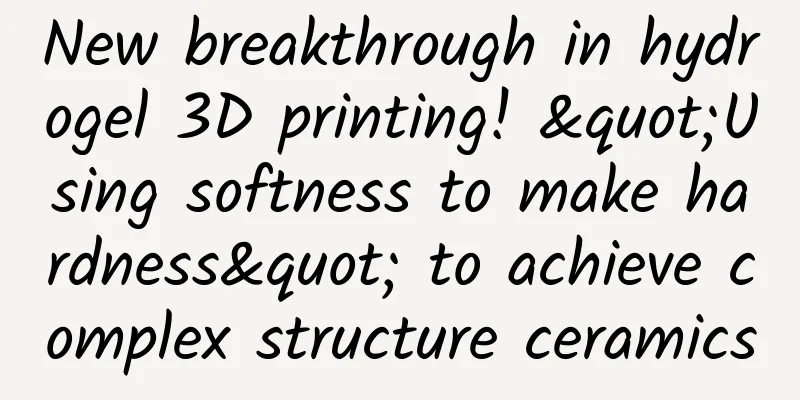New breakthrough in hydrogel 3D printing! "Using softness to make hardness" to achieve complex structure ceramics

|
Produced by: Science Popularization China Producer: China Science Expo Editor's note: In order to unveil the mystery of scientific work, the China Science Popularization Frontier Science Project launched a series of articles called "Me and My Research", inviting scientists to write articles themselves, share their scientific research experiences, and create a scientific world. Let us follow the explorers at the forefront of science and technology and embark on a journey full of passion, challenges, and surprises. Clay becomes soft and plastic after mixing with water, and can be kneaded, carved and shaped. Through special drying and firing processes, the clay is transformed from a plastic state into hard and durable pottery or sculptures. Through a special "baking" process, this "clay" becomes hard ceramics. Flexible hydrogel ceramic precursor is such a "magic clay". With it, we have solved the problem of making ceramics with complex shapes. So, how do we make this "magic soil" and how do we "dry" it? The only thing that ceramics lack from being “high-end” is to become “soft” We know that ceramic materials have excellent high-temperature stability, corrosion resistance, wear resistance and good electrical insulation. Such excellent physical and chemical properties also make ceramics a material for manufacturing many daily necessities. Image source: veer gallery In fact, in addition to being made into household pots and pans, ceramics with many advantages can play a role in more fields. However, their properties of being too hard and too brittle limit the application of traditional ceramic materials (resin-based ceramic precursors) in more "high-end" scenarios. First, it is difficult to manufacture complex shapes with traditional ceramic materials , especially in the manufacture of complex geometric shapes and embedded structures. This is because ceramic materials are often processed by molding, slip casting and extrusion. Ceramics also need to be sintered at high temperatures to obtain the final mechanical properties. This process often causes shrinkage and deformation of the material, limiting the precise manufacture of complex structures. Second, when manufacturing high-precision parts, traditional ceramic processing methods have difficulty in dimensional control , especially for micro-sized parts. Due to material shrinkage and uncontrollable factors during sintering, it is often difficult to achieve high precision, and traditional ceramics often require secondary processing (such as grinding and polishing) after sintering, which greatly increases production costs and complexity. In addition, during the traditional preparation process, ceramic materials are prone to cracks, pores and other defects , which can significantly reduce the mechanical properties and reliability of the materials. These defects are unacceptable, especially in high-precision and high-strength application scenarios. Image source: veer gallery To this end, scientists began to wonder whether they could develop a "magic clay" that could change its shape or performance under specific circumstances, allowing ceramic materials to play a greater role? To achieve both rigidity and flexibility, just add ceramics to hydrogel It is not easy to make such a "magic clay". We need it to be as soft and easy to shape as plasticine during the molding stage, but also as hard and durable as ceramics after molding. Obviously, it is difficult for existing materials to meet such contradictory requirements. Inspired by paper-cutting art and smart materials, the researchers thought that flexible hydrogel is a material with a certain degree of deformability, which can show a variety of properties during processing or use. So, can ceramics be combined with the characteristics of this material so that it can be "cut" into the shape we need like paper-cutting? The team of the Key Laboratory of Lubricating Materials at the Lanzhou Institute of Chemical Physics, Chinese Academy of Sciences has been engaged in the research of 3D printing hydrogels and ceramic materials. We want to combine these two completely different materials, using the flexibility of hydrogels to achieve the hardness of ceramics through phase change, thereby achieving the ideal effect of "using softness to overcome hardness". However, problems soon emerged. The huge differences in the physical properties of hydrogels and ceramics made it difficult for the material to maintain a stable structure after molding, and there were problems of large dimensional shrinkage and structural cracking. In order to better combine the two materials, we thought of a result that the team had previously published - a basic method for making low-temperature sintering and ultra-low shrinkage ceramics using water-based inorganic binders . So, we tried to dissolve the hydrogel monomer into this water-based inorganic binder and introduced a certain amount of ceramic powder to produce a water-based ceramic slurry with photocurable properties. We found that after photocuring this material, followed by drying, degreasing and sintering, we can produce an ultra-low shrinkage ceramic without cracking. This means that the "magic clay" - a flexible hydrogel ceramic precursor has been successfully developed! A scheme for photocurable 3D printing of hydrogel flexible precursors to assist in the fabrication of complex ceramic structures (Image source: Lanzhou Institute of Chemical Physics, Chinese Academy of Sciences) What is the preparation process of hydrogel precursor? 1. Using aluminum dihydrogen phosphate sol as the dispersion medium, hydrogel monomer and nano-ceramic powder were mixed to prepare photosensitive hydrogel ceramic slurry. 2. Mix hydrogel monomers such as acrylamide and acrylic acid, water-soluble initiator LAP, nano-ceramic powders such as alumina and hydroxyapatite with aluminum dihydrogen phosphate sol prepared by the team to prepare photosensitive hydrogel ceramic slurry. The hydrogel monomer mainly gives the ceramic slurry excellent photocuring properties, and the aluminum dihydrogen phosphate sol not only serves as a dispersion medium, but also as a ceramic binder. This research successfully combines flexibility and rigidity, and also provides materials scientists with a new way of thinking - materials are no longer just the embodiment of a single property, but can achieve more complex and extensive applications through the organic combination of multiple properties. From flat to three-dimensional, 3D printing ceramics have many advantages In order to make ceramics more widely used, in addition to solving the problem of shaping, we also have to consider how to make the "magic clay" hard. For this, the researchers thought of 3D printing. 3D printing technology can use some bondable materials to construct physical parts by printing layer by layer. If it can be combined with flexible hydrogel ceramic precursors, we can create products or devices with more complex structures and make them suitable for more application scenarios. Specifically, we can first use photo-curing 3D printing technology to obtain a hydrogel flexible skeleton with excellent ductility, shape adaptability and fatigue resistance. Then, after dehydration and drying, low-temperature degreasing and high-temperature sintering, it becomes hard and forms a ceramic structure with ultra-low shrinkage, high ceramic yield and shape fidelity. This technology has achieved important breakthroughs in materials science and manufacturing technology for the manufacture of three-dimensional complex structure devices, and has promoted the application of new ceramic materials in multiple fields. In the medical field, flexible hydrogel ceramic precursors can be used to manufacture implants that fully match the patient's anatomical structure. For example, the deformability of the hydrogel flexible skeleton can be used to customize the ceramic structure to repair the bone defect in response to the different skull defect shapes of the patient. In the aerospace field, it can be combined with other functional materials to manufacture complex aerospace structures . The high thermal conductivity and heat resistance of ceramic materials make them ideal heat dissipation materials for making electronic components. Combining this technology can produce precisely designed heat sinks to improve the performance and reliability of electronic products. In addition, it can also be combined with surface modification strategies to prepare complex structure catalytic ceramic devices with excellent catalytic activity and stability... Unsupported, large-span complex structure ceramic devices fabricated with the aid of hydrogel flexible precursors (Image source: Lanzhou Institute of Chemical Physics, Chinese Academy of Sciences) Breaking through limitations, many advantages The combination of flexible hydrogel-based ceramic precursors and 3D printing technology breaks through the limitations of traditional hard or brittle ceramic precursors to manufacture complex ceramic structures, bringing many advantages: 1. More freedom in design and functional integration Because the flexible ceramic precursor has a certain degree of flexibility before solidification, it allows people to integrate more complex designs and functions, such as internal channels, honeycomb structures, or multi-material combinations. 3D printing can achieve complex and customized ceramic structures while maintaining high precision. 2. Material performance optimization and controllable sintering process Flexible ceramic precursors can maintain a certain toughness during the forming process, reduce the generation of cracks and defects, and thus achieve high strength and toughness in the final sintered ceramic material; by adjusting the combination of 3D printing and flexible ceramic precursors, researchers can precisely control the sintering process of the material, thereby optimizing the microstructure and properties of the material. 3. Innovation in manufacturing technology and design methods By combining the concept of smart materials, flexible ceramic precursors can exhibit programmable properties under specific conditions during the 3D printing process, giving the final ceramic products a wider range of application possibilities; combined with 3D printing technology, flexible ceramic precursors can be printed together with other materials to form a multi-material composite structure, combining the excellent properties of ceramic materials and the functionality of other materials in one component. 4. Expansion of innovative application areas Flexible ceramic precursors can be widely used in biomedicine and electronic devices. For example, dental implants and bone substitutes only have the biocompatibility of ceramic materials, and can also be customized according to the specific needs of patients; the combination of 3D printing and flexible ceramic precursors can produce high-performance electronic devices, such as high-temperature resistant insulators, sensor housings, etc. These devices need to have both high precision and specific electrical properties. Overall, the combination of 3D printing and flexible ceramic precursors provides a new way to manufacture complex, high-performance ceramic components, pushing the frontier of materials science and manufacturing technology. Application of new ceramic structures in three-dimensional circuits, biomedicine and functional catalysis (Image source: Lanzhou Institute of Chemical Physics, Chinese Academy of Sciences) The further development of 3D printing flexible hydrogel precursor technology will not only provide a new manufacturing method for existing ceramic products, but will also promote the application of ceramic materials in more emerging fields. The development of this technology will rely on the innovation of multidisciplinary cooperation, and ultimately achieve large-scale promotion and industrial application of the technology. |
<<: Can't eat watermelon in autumn, will it cause stomach upset? The truth is...
>>: Wonderful pictures in movies: Why has Han Huang’s “Five Oxen” become a classic in cow painting?
Recommend
More than 5,000 years ago, they lived in "three bedrooms and one living room"
On the banks of the great river, there are relics...
It’s quiet now. Alipay has cracked down on pop-up ads, reducing them by 70%.
[[406905]] As a national-level APP, Alipay has br...
Coolpad Changer S1 Review: Define Youth with Sound Quality and Design
2016 was a year of major changes for Coolpad. Coo...
Princess Taiping Introduction: The impact of internal chain factors on website SEO ranking
The homepage here not only refers to the domain n...
Southeast Asia Automotive Wars: 300 units of Xiaopeng X9 pure electric MPVs are heading to Thailand, and the industry is undergoing major changes
On February 22, at Guangzhou Port, 300 units of X...
Authoritative interview! Detailed explanation of COVID-19 symptoms within 7 days of onset! How to quickly turn from positive to negative? A picture comparison →
The following article is from Beijing News Radio,...
Growth Hacking | User Growth Tips from Google!
The concept of growth hacking has always been ver...
Doctor Who (All 12 Seasons + Specials + Specials) HD English Subtitles
Chinese name: Doctor Who Foreign name: Doctor Who...
Brand Spring Festival Marketing War
There are less than 3 weeks left until the 2022 S...
Apple iOS 15 leak summary: In addition to new icons, new lock screen, new notifications, there are 3 major changes
If you are a qualified Apple fan, even if there a...
How much does it cost to attract investors for the Baoding fast food mini program? What is the investment quotation for Baoding fast food mini program?
How much does it cost to attract investors for th...
Masters' Battle: Sima Yi's Four Survival Philosophies
Zhang Jinyang—— One of the top ten female lecture...
Workers flock to traditional Chinese medicine hospitals for massage, and doctors urgently recommend...
Review expert: Wang Linyu, deputy chief physician...
This lizard, named after the snake monster, has the ability to walk on water.
In the martial arts novel The Legend of the Condo...









